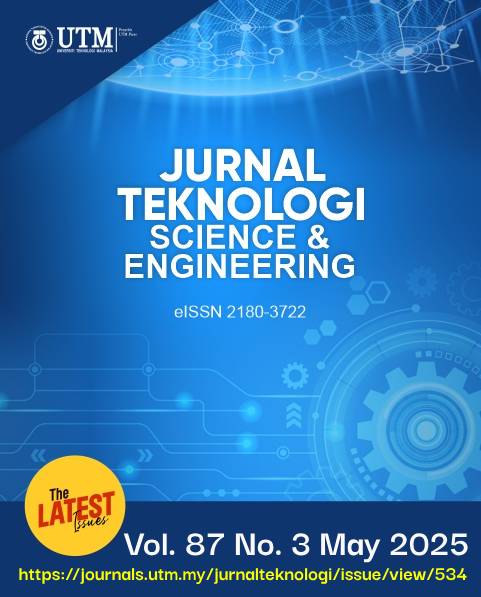A COMPARATIVE STUDY ON STRENGTHENING FLEXIBLE PAVEMENT BY ADDING SELECTED MEDICAL WASTE FIBRE IN MODIFIED BITUMEN PENETRATION GRADE 60/70
DOI:
https://doi.org/10.11113/jurnalteknologi.v87.22970Keywords:
Disposable face mask, medical waste, modified bitumen, nitrile butadiene rubber glove, SMA-14 mixturesAbstract
The COVID-19 pandemic has led to an increase in worldwide consumption of nitrile butadiene rubber (NBR) gloves and disposable face masks (DFM), resulting in environmental contamination. Thus, this research was conducted to compare the physical properties of modified bitumen penetration grade 60/70 and to evaluate the performance of modified Stone Mastic Asphalt (SMA-14) mixtures when using both materials as fibers. NBR gloves and DFM were collected around the campus of Universiti Teknologi MARA (UiTM) Permatang Pauh and were later sanitized and cut into strips of 6 mm maximum length. By applying the softening point and penetration tests, the physical parameters of modified bitumen PEN 60/70 were compared to those of bitumen with NBR and DFM as additives. The Unconfined Compression Strength (UCS) and binder drain-down tests were also conducted to compare the performance and binder-draining properties of modified SMA-14 mixtures using both dry and wet process methods when both fibers were added. The results showed that adding 3%, 6%, and 9% of NBR to modified bitumen PEN 60/70 increases the softening value and penetration depth, while DFM decreases both test values for all percentages. Besides, 3% NBR and 6% DFM strengthen the mixtures, making the bitumen less likely to drain in both dry and wet processing. All test results were compared against the Public Works Department’s requirements and passed the set standard. It is concluded that adding 3% NBR and 6% DFM as pavement additives positively impacts its performance and increases the service life.
References
Harapan, H., Itoh, N., Yufika, A., et al. 2020. Coronavirus Disease 2019 (COVID-19): A Literature Review. Journal of Infection and Public Health. 13: 667–673.
Doi: https://doi.org/10.1016/j.jiph.2020.03.019.
Guan, D., Wang, D., Hallegatte, S., et al. 2020. Global Supply-Chain Effects of COVID-19 Control Measures. Nature Human Behaviour. 4: 577–587.
Doi: https://doi.org/10.1038/s41562-020-0896-8.
Acter. T., Uddin, N., Das, J., Akhter, A., Choudhury, T. R. and Kim, S. 2020. Evolution of Severe Acute Respiratory Syndrome Coronavirus 2 (SARS-CoV-2) As Coronavirus Disease 2019 (COVID-19) Pandemic: A Global Health Emergency. Science of the Total Environment. 730: 138996.
Doi: https://doi.org/10.1016/j.scitotenv.2020.138996.
Siwal, S. S., Chaudhary, G., Saini, A. K., et al. 2021. Key Ingredients and Recycling Strategy of Personal Protective Equipment (PPE): Towards Sustainable Solution for the COVID-19 Like Pandemics. Journal of Environmental Chemical Engineering. 9: 106284. Doi: https://doi.org/https://doi.org/10.1016/j.jece.2021.106284.
Kampf, G., Todt, D., Pfaender, S. and Steinmann, E. 2020. Persistence of Coronaviruses on Inanimate Surfaces and Their Inactivation with Biocidal Agents. Journal of Hospital Infection. 104: 246–251.
Doi : https://doi.org/10.1016/j.jhin.2020.01.022.
Nowakowski, P., Kuśnierz, S., Sosna, P., et al. 2020. Disposal of Personal Protective Equipment during the COVID-19 Pandemic Is a Challenge for Waste Collection Companies and Society: A Case Study in Poland. Resources. 9(10): 116. Doi: https://doi.org/10.3390/resources9100116.
You, L., Long, Z., You, Z., Ge, D., Yang, X., Xu, F., Hashemi, M. and Diab, A. 2022. Review of Recycling Waste Plastics in Asphalt Paving Materials. Journal of Traffic and Transportation Engineering. 9(5): 742–764.
Doi: https://doi.org/10.1016/j.jtte.2022.07.002.
Martinho, F. C. G., Silva, H. M. R. D., Oliveira, J. R. M., et al. 2023. Mechanical and Environmental Performance of Asphalt Concrete with High Amounts of Recycled Concrete Aggregates (RCA) for Use in Surface Courses of Pavements. Sustainability. 16(1): 248.
Doi: https://doi.org/10.3390/su16010248.
Al-Mistarehi, B. W., Khadaywi, T. S., Khaled Hussein, A. 2021. Investigating the Effects on Creep and Fatigue Behavior of Asphalt Mixtures with Recycled Materials as Fillers. Journal of King Saud University - Engineering Sciences. 33(5): 355–363. Doi: https://doi.org/10.1016/j.jksues.2020.09.004.
Gedik, A., Ozcan, O. and Ozcanan, S. 2023 Recycling COVID-19 Health Care Wastes in Bitumen Modification: A Case of Disposable Medical Gloves. Environmental Science and Pollution Research. 30(30): 74977–74990.
Doi: https://doi.org/10.1007/s11356-023-27488-y.
Hasban, A., Waje, A., Vhatte, V., et al. 2022. Study of Effective Utilization of Waste P.E.T (Plastic) and Steel Slag to Enhance the Performance of Bitumen Based Pavement. International Journal for Research in Applied Science and Engineering Technology. 10(4): 3172–3177.
Doi : https://doi.org/10.22214/ijraset.2022.42031.
Crusho, A. B. and Verghese, V. 2019. Medical Plastic Waste Disposal by Using in Bituminous Road Construction. International Research Journal of Multidisciplinary Technovation. 668–676.
Doi: https://doi.org/10.34256/irjmtcon95.
Shah S. S. A, and Khan R. 2016. Re-Use of Hospital Plastic Waste in Asphalt Mixes as Partial Replacement of Coarse Aggregate. Open Journal of Civil Engineering. 06(03): 381–387. Doi: https://doi.org/10.4236/ojce.2016.63032.
Jabatan Kerja Raya Malaysia. 2008. Standard Specification for Road Works - Section 4: Flexible Pavement (JKR/SPJ/2008-S4). Kuala Lumpur: Jabatan Kerja Raya Malaysia.
Noura, S., Al-Sabaeei, A. M., Safaeldeen, G. I., et al. 2021. Evaluation of Measured and Predicted Resilient Modulus of Rubberized Stone Mastic Asphalt (SMA) Modified with Truck Tire Rubber Powder. Case Studies in Construction Materials. 15: e00633. Doi: https://doi.org/10.1016/j.cscm.2021.e00633.
Appiah, J. K., Berko-Boateng, V. N., and Tagbor, T. A. 2017. Use of Waste Plastic Materials for Road Construction in Ghana. Case Studies in Construction Materials. 6: 1–7. Doi: https://doi.org/https://doi.org/10.1016/j.cscm.2016.11.001.
Shafii, M. A., Chia, S. J. and Rais, N. M. 2018. Hot Mix Asphalt (HMA) Properties Using Natural Rubber Latex (NRL)-Modified Bitumen. International Journal of Engineering and Technology (UAE). 7: 3241–3244.
Doi: https://doi.org/10.14419/ijet.v7i4.13735.
White, G. and Hall, F. 2021. 100th Transportation Research Board Annual Meeting: a virtual event [Online]. Available: https://www.tam-portal.com/events/transportation-research-board-trb-100th-annual-meeting/
Devulapalli, L., Sarang, G. and Kothandaraman, S. 2022. Characteristics of Aggregate Gradation, Drain Down and Stabilizing Agents in Stone Matrix Asphalt Mixtures: A State of Art Review. Journal of Traffic and Transportation Engineering (English Edition). 9: 167–179.
Doi: https://doi.org/https://doi.org/10.1016/j.jtte.2021.10.007.
Eskandarsefat, S., Dondi, G., Sangiorgi C. 2019. Recycled and Rubberized SMA Modified Mixtures: A Comparison Between Polymer Modified Bitumen and Modified Fibres. Construction and Building Materials. 202: 681–691.
Downloads
Published
Issue
Section
License
Copyright of articles that appear in Jurnal Teknologi belongs exclusively to Penerbit Universiti Teknologi Malaysia (Penerbit UTM Press). This copyright covers the rights to reproduce the article, including reprints, electronic reproductions, or any other reproductions of similar nature.
















